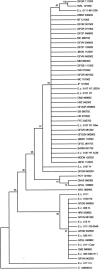tir- and stx-positive Escherichia coli in stream waters in a metropolitan area
- PMID: 15870341
- PMCID: PMC1087540
- DOI: 10.1128/AEM.71.5.2511-2519.2005
tir- and stx-positive Escherichia coli in stream waters in a metropolitan area
Abstract
Diarrheagenic Escherichia coli, which may include the enteropathogenic E. coli and the enterohemorrhagic E. coli, are a significant cause of diarrheal disease among infants and children in both developing and developed areas. Disease outbreaks related to freshwater exposure have been documented, but the presence of these organisms in the urban aquatic environment is not well characterized. From April 2002 through April 2004 we conducted weekly surveys of streams in the metropolitan Baltimore, Md., area for the prevalence of potentially pathogenic E. coli by using PCR assays targeting the tir and stx(1) and stx(2) genes. Coliforms testing positive for the presence of the tir gene were cultured from 653 of 1,218 samples (53%), with a greater prevalence associated with urban, polluted streams than in suburban and forested watershed streams. Polluted urban streams were also more likely to test positive for the presence of one of the stx genes. Sequence analysis of the tir amplicon, as well as the entire tir gene from three isolates, indicated that the pathogenic E. coli present in the stream waters has a high degree of sequence homology with the E. coli O157:H7 serotype. Our data indicate that pathogenic E. coli are continually deposited into a variety of stream habitats and suggest that this organism may be a permanent member of the gastrointestinal microflora of humans and animals in the metropolitan Baltimore area.
Figures






Similar articles
-
Incidence of Escherichia coli O157:H7 and E. coli virulence factors in US bulk tank milk as determined by polymerase chain reaction.J Dairy Sci. 2007 Jul;90(7):3212-9. doi: 10.3168/jds.2006-009. J Dairy Sci. 2007. PMID: 17582104
-
Identification of human-pathogenic strains of Shiga toxin-producing Escherichia coli from food by a combination of serotyping and molecular typing of Shiga toxin genes.Appl Environ Microbiol. 2007 Aug;73(15):4769-75. doi: 10.1128/AEM.00873-07. Epub 2007 Jun 8. Appl Environ Microbiol. 2007. PMID: 17557838 Free PMC article.
-
Impact of microbial diversity on rapid detection of enterohemorrhagic Escherichia coli in surface waters.FEMS Microbiol Lett. 2006 Aug;261(1):95-101. doi: 10.1111/j.1574-6968.2006.00334.x. FEMS Microbiol Lett. 2006. PMID: 16842365
-
Polymerase chain reaction screening for Salmonella and enterohemorrhagic Escherichia coli on beef products in processing establishments.Foodborne Pathog Dis. 2011 Sep;8(9):1045-53. doi: 10.1089/fpd.2010.0825. Epub 2011 May 11. Foodborne Pathog Dis. 2011. PMID: 21561381
-
Subcutaneous and intranasal immunization with Stx2B-Tir-Stx1B-Zot reduces colonization and shedding of Escherichia coli O157:H7 in mice.Vaccine. 2011 May 17;29(22):3923-9. doi: 10.1016/j.vaccine.2011.02.007. Epub 2011 Feb 21. Vaccine. 2011. PMID: 21338683
Cited by
-
Comparative prevalence of Escherichia coli carrying virulence genes and class 1 and 2 integrons in sub-tropical and cool temperate freshwater.Environ Sci Pollut Res Int. 2017 Aug;24(22):18263-18272. doi: 10.1007/s11356-017-9497-0. Epub 2017 Jun 21. Environ Sci Pollut Res Int. 2017. PMID: 28634805
-
Comparative metagenome of a stream impacted by the urbanization phenomenon.Braz J Microbiol. 2016 Oct-Dec;47(4):835-845. doi: 10.1016/j.bjm.2016.06.011. Epub 2016 Jul 4. Braz J Microbiol. 2016. PMID: 27522532 Free PMC article.
-
Antimicrobial resistance, virulence factors and genetic diversity of Escherichia coli isolates from household water supply in Dhaka, Bangladesh.PLoS One. 2013;8(4):e61090. doi: 10.1371/journal.pone.0061090. Epub 2013 Apr 3. PLoS One. 2013. PMID: 23573295 Free PMC article.
-
Relationship between phylogenetic groups, genotypic clusters, and virulence gene profiles of Escherichia coli strains from diverse human and animal sources.Appl Environ Microbiol. 2007 Sep;73(18):5703-10. doi: 10.1128/AEM.00275-07. Epub 2007 Jul 20. Appl Environ Microbiol. 2007. PMID: 17644637 Free PMC article.
-
Large scale analysis of virulence genes in Escherichia coli strains isolated from Avalon Bay, CA.Water Res. 2010 Oct;44(18):5463-73. doi: 10.1016/j.watres.2010.06.058. Epub 2010 Jun 30. Water Res. 2010. PMID: 20643468 Free PMC article.
References
-
- Blank, T. E., J.-P. Nougayrede, and M. S. Donnenberg. 2002. Enteropathogenic Escherichia coli, p. 81-118. In M. Donnenberg (ed.), Escherichia coli: virulence mechanisms of a versatile pathogen. Academic Press, Inc., New York, N.Y.
-
- Bokete, T. N., T. S. Whittam, R. A. Wilson, C. R. Clausen, C. M. O'Callahan, S. L. Moseley, T. R. Fritsche, and P. I. Tarr. 1997. Genetic and phenotypic analysis of Escherichia coli with enteropathogenic characteristics isolated from Seattle children. J. Infect. Dis. 175:1382-1389. - PubMed
Publication types
MeSH terms
Substances
Associated data
- Actions
- Actions
- Actions
- Actions
LinkOut - more resources
Full Text Sources
Molecular Biology Databases
Miscellaneous

